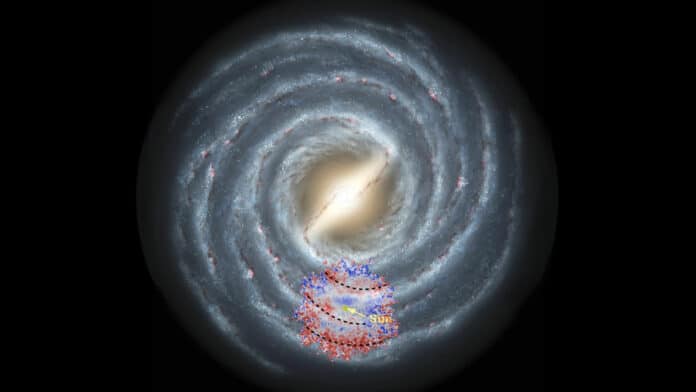Chemical Cartography, or mapping, of our Galaxy has the potential to transform our view of its structure and formation fully. It shows how the periodic table elements are distributed throughout the Milky Way. They enable astronomers to identify the location of celestial objects based on their chemical composition rather than the light they emit.
Keith Hawkins, an assistant professor of astronomy at The University of Texas at Austin, has discovered previously undiscovered parts of the Milky Way’s spiral arms using chemical cartography, also known as chemical mapping. He demonstrated the importance of pioneering techniques in understanding our home Galaxy’s shape, structure, and evolution.
Milky Way is a spiral galaxy. However, its exact form, structure, and number of arms are still been a matter of investigation. That’s because we live inside our home Galaxy and cannot travel far enough to see it from an outsider’s perspective.
Astronomers have built accurate models of the Milky Way, and artists have created stunning depictions despite our restricted ability to see it.
Hawkins said, “But, I wanted to determine how those models and illustrations are. And to see if chemical cartography could reveal a clearer view of the Milky Way’s spiral arms.”
By detecting the light that young stars radiate, astronomers can find them. However, dust clouds occasionally block out stars, making it challenging for even the greatest telescopes to see their light. Because of this, some parts of the Milky Way’s arms are yet unexplored.
Astronomers use chemical cartography to fill in the blanks. It does so by relying on an astronomical concept called “metallicity.” Metallicity refers to the ratio of metals to hydrogen present on a star’s surface.
Hawkins determined the Milky Way’s metallicity‘s dispersion to create his map. He focused on the region of up to 32,600 light-years surrounding our sun, for which this data is available. It was anticipated that areas with many metal-rich things would align with the spiral arms, whereas areas with few metal-rich objects would align with the spaces between them.
The spiral arms lined up with one another when he compared his map to others of the same Milky Way region. In addition, new regions that had previously been unexplored appeared because Hawkins’ map identifies the spiral arms based on metallicity rather than the light radiated by young stars.
Hawkins said, “A big takeaway is that the spiral arms are richer in metals. This illustrates the value of chemical cartography in identifying the Milky Way’s structure and formation. It has the potential to transform our view of the Galaxy fully.”
Hawkins used data from the Gaia space telescope and the Large Sky Area Multi-Object Fibre Spectroscopic Telescope (LAMOST) for his investigation. Gaia’s third Data Release included some interesting new data.
Hawkins said, “The sheer volume of data available from Gaia allows us to do chemical cartography at a galactic scale now. Data on the positions of billions of stars and their chemical makeup wasn’t available until recently.”
So far, Gaia has provided chemical data for the largest area of the Milky Way to date. However, this still only accounts for about one percent of the Galaxy. As Gaia continues to survey the heavens, and as new telescopes come online, astronomers can increasingly use chemical cartography to understand fundamental properties of our home Galaxy.
Journal Reference:
- Keith Hawkins. Chemical Cartography with LAMOST and Gaia Reveal Azimuthal and Spiral Structure in the Galactic Disk. Monthly Notices of the Royal Astronomical Society. DOI: 10.1093/mnras/stad1244
